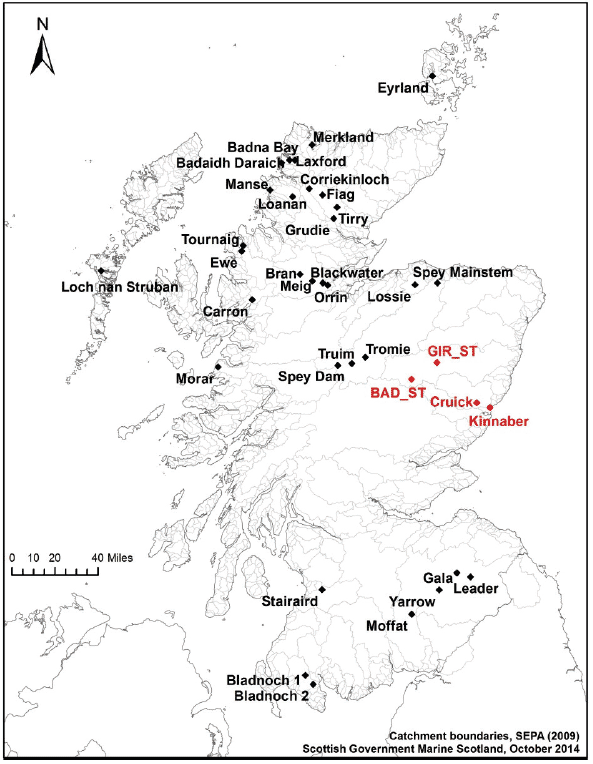Scottish Marine and Freshwater Science Volume 6 Number 2: Spatio-temporal variability in Scottish smolt emigration times and sizes
Information on smolt sizes is required to plan acoustic tagging studies aiming to improve understanding of fish movement and behaviour in the coastal zone, to aid planning for marine renewables. This report assessed pre-existing information on smolt migra
Methods
Data Collation
Data on smolt emigration times and sizes were obtained from fisheries trusts, fisheries boards, universities and private companies and compiled under a Marine Scotland contract to the Scottish Fisheries Coordination Centre ( SFCC, 2014). This was supplemented by monitoring data from Marine Scotland Science Freshwater Fisheries Laboratory. A map showing the locations of the sampling sites in the final dataset is shown in Figure 1. Smolt data were collected by a wide range of methods including fixed and temporary, partial and full river traps and rotary screw traps. It is important to note that these data were collected for varying purposes, but that the objectives of these studies were not necessarily the same as those of this report. Although this is inevitable in any large scale opportunistic meta-data analysis, it should be borne in mind.
To facilitate analysis, a number of assumptions were made about the data. Firstly, it is assumed that fish are caught in proportion to the numbers of emigrating fish and thus that capture efficiency remains constant within years. Secondly it is assumed that the captured fish provide a representative sample of migrating fish and there is no size selection in the capture process.
Data Analysis
Emigration Time
The temporal distribution of smolt migration times was visualised by plotting smolt counts against Day of the Year (DoY) for each Site and Year. The onset of smolt migration was characterised as the DoY on which 25 percent of emigrants had been captured (S25). The end of the smolt migration was characterised using the 75 th percentile (S75). These definitions of the start and end of the smolt run were chosen to allow comparison with previous studies (Antonsson and Gudjonsson, 2002; Otero et al., 2014) and because more extreme percentiles would be more variable and challenging to model.
S25 and S75 were modelled as a function of plausible environmental predictors obtained from a GIS including Latitude, Longitude, Coast (whether rivers drained to the east, west or north coasts), Distance Around Coast, Elevation (the altitude of the trapping site), Distance From Sea (a river network distance from the trapping site to the sea) and Year, assuming normally distributed errors. Preliminary investigations revealed that Distance From Sea and Elevation were highly correlated, so only Elevation was included in model fitting. Site was modelled as a random effect to account for inter-site variation. Smoothers were used to investigate non-linearity. Where there was no evidence of non-linearity, linear effects were investigated. Model selection was undertaken using a step down procedure using likelihood ratio tests.
Figure 1: Map showing the spatial distribution of sites where data on salmon smolts was collected. MSS sites are shown in red. Sites provided by the SFCC data collation contract ( SFCC, 2014) are shown in black.

Smolt size
Given the limited number of sites for which high precision (1mm) smolt size information was available, a formal statistical analysis was not performed. Instead, the distribution of fish sizes was plotted for each Site and Year, along with the 135mm size threshold. The percentage of fish exceeding this threshold was then summarised and tabulated for each site and year where data were available.
Contact
There is a problem
Thanks for your feedback